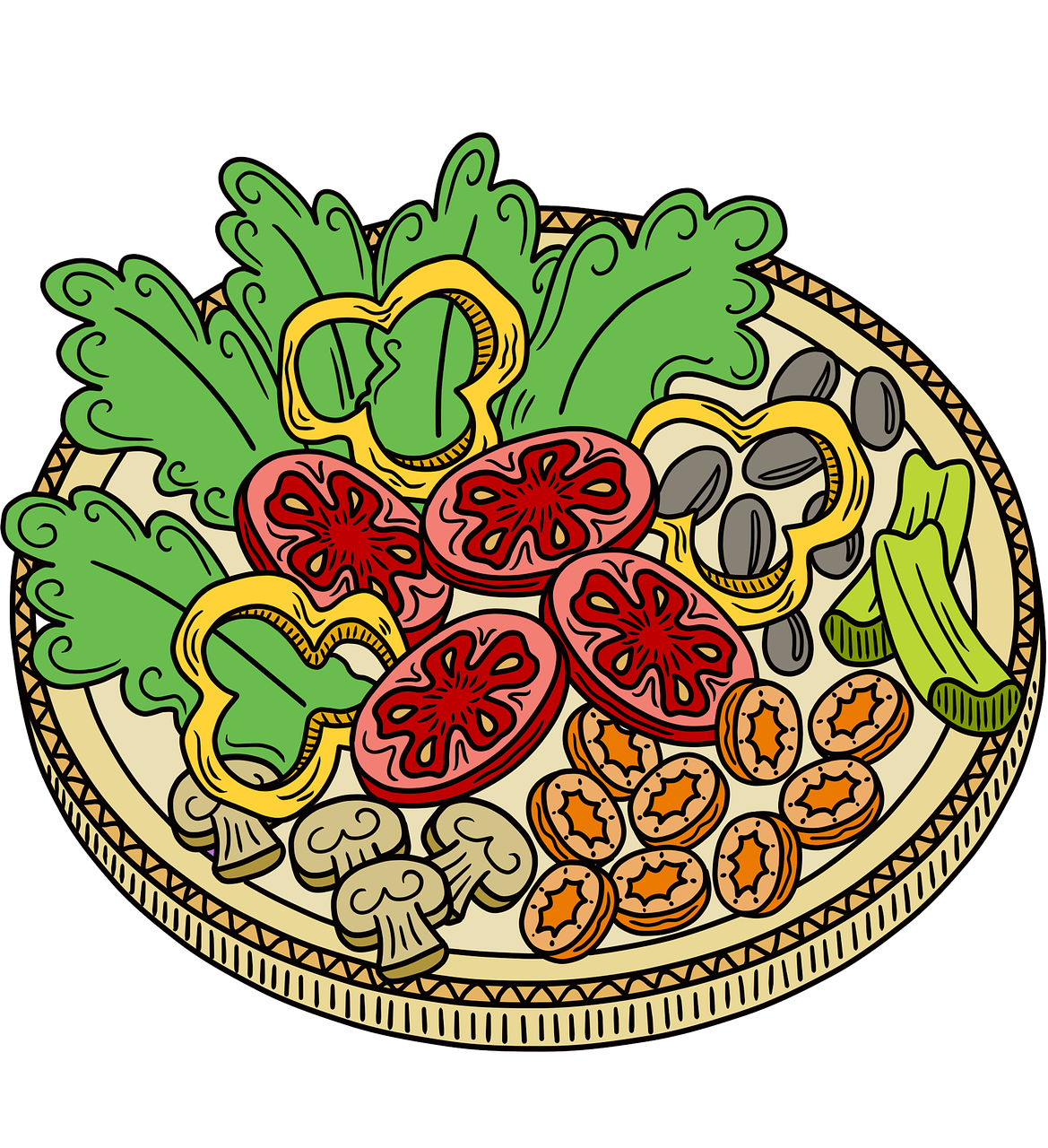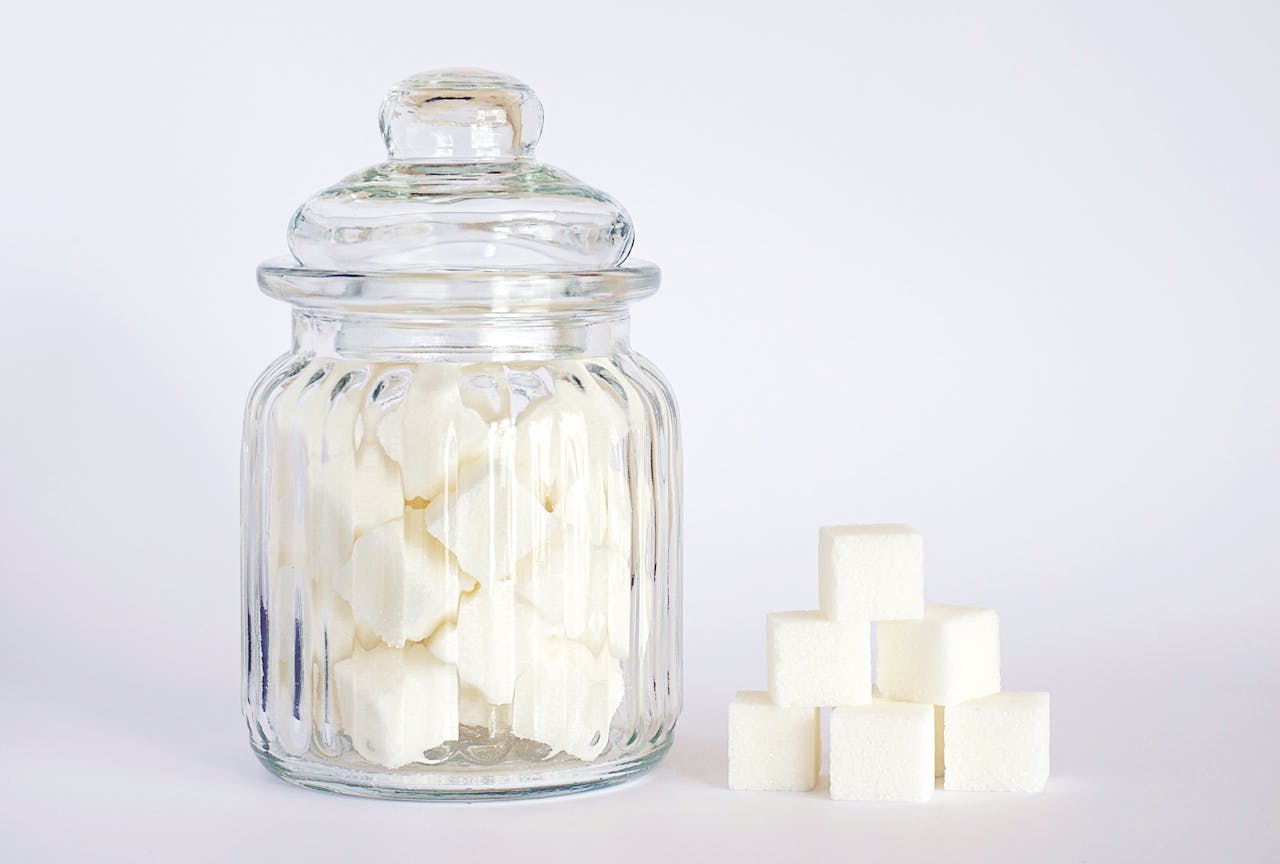10 Delicious Anti Inflammatory Salads Recipes for Health

Inflammation is your body’s way of signalling that something is wrong. While acute inflammation is beneficial for healing, chronic inflammation can contribute to serious health problems. Persistent inflammation has been linked to conditions such as:
- Heart Disease: Chronic inflammation can damage blood vessels, leading to
- Diabetes: Inflammation affects insulin resistance, increasing the risk of type 2 diabetes.
- Arthritis: Inflammatory responses can deteriorate joint health, causing pain and stiffness.
- Cancer: Prolonged inflammation may promote the development and growth of cancer cells.
- 10 Delicious Anti Inflammatory Salads Recipes for Health
- The Power of Salads in Combating Inflammation
- The Science Behind Anti-Inflammatory Salads
- 10 Delicious Anti Inflammatory Salad Recipes
- 1. Berry and Spinach Superfood Salad
- 2. Mediterranean Quinoa Salad
- 3. Turmeric Roasted Vegetable Salad
- 4. Avocado and Grapefruit Salad with Citrus Vinaigrette
- 5. Kale and Sweet Potato Salad with Tahini Dressing
- 6. Salmon and Broccoli Slaw Salad
- 7. Asian-Inspired Ginger Sesame Salad
- 8. Greek-Style Anti-Inflammatory Salad
- 9. Rainbow Chopped Salad with Lemon Garlic Dressing
- 10. Walnut and Apple Salad with Maple Vinaigrette
- Conclusion
- FAQ
The Power of Salads in Combating Inflammation
Salads are more than just a side dish; they can be a powerhouse of nutrients that fight inflammation. By combining a variety of anti-inflammatory ingredients, salads provide essential vitamins, minerals, antioxidants, and healthy fats that support overall health and reduce inflammatory markers in the body.
Understanding Anti Inflammatory Salads Ingredients
Anti-inflammatory foods typically contain:
- Antioxidants: Protect cells from damage caused by free radicals.
- Healthy Fats Support cell structure and reduce inflammatory processes.
- Fiber: Aids digestion and regulates blood sugar levels.
- Phytonutrients: Plant-based compounds that have anti-inflammatory properties.
Top Anti-Inflammatory Ingredients for Salads
Leafy Greens (Kale, Spinach, Collards)
Rich in vitamins A, C, and K, leafy greens are fundamental to anti-inflammatory salads. They also contain antioxidants like beta-carotene and lutein, which help combat oxidative stress.
Colorful Vegetables (Bell Peppers, Tomatoes)
Brightly colored vegetables are packed with vitamins and antioxidants. Bell peppers, for instance, are high in vitamin C, while tomatoes provide lycopene, a powerful anti-inflammatory compound.
Healthy Fats (Avocado, Olive Oil, Nuts)
Healthy fats from sources like avocados, olive oil, and nuts help decrease inflammatory markers in the body. They also enhance the absorption of fat-soluble vitamins.
Herbs and Spices (Turmeric, Ginger, Garlic)
Turmeric contains curcumin, a potent anti-inflammatory agent. Ginger and garlic also have strong anti-inflammatory and antioxidant properties, adding both flavor and health benefits to your salads.
The Science Behind Anti-Inflammatory Salads
Numerous studies have demonstrated that anti-inflammatory diets can reduce the risk of chronic diseases. The Mediterranean diet, rich in fruits, vegetables, whole grains, and healthy fats, is a prime example of an anti-inflammatory eating pattern that has been associated with lower inflammation levels and improved heart health.
How Specific Ingredients Work to Reduce Inflammation
- Turmeric (Curcumin)**: Inhibits inflammatory pathways and reduces the production of pro-inflammatory cytokines.
- Omega-3 Fatty Acids (from Nuts and Seeds): Decrease the production of inflammatory molecules and support heart health.
- Antioxidants (from Berries and Leafy Greens): Neutralize free radicals, preventing cellular damage and inflammation.
Building the Perfect Anti-Inflammatory Salad
Base: Choosing the Right Greens
Start with a base of nutrient-dense leafy greens. Options include:
- Kale: High in vitamins K, A, and C.
- Spinach: Rich in iron and magnesium.
- Collards: Packed with fiber and antioxidants.
Toppings: Balancing Flavors and Textures
Incorporate a variety of colorful vegetables and fruits to add different textures and flavors. Consider adding:
- Bell Peppers: Crunchy and sweet.
- Cherry Tomatoes: Juicy and tangy.
- Berries: Sweet and tart.
Proteins: Plant-Based and Lean Animal Options
Include a source of protein to make your salad more filling and balanced. Options include:
- Grilled Chicken or Salmon: Lean animal proteins rich in omega-3s.
- Chickpeas or Lentils: Plant-based proteins high in fiber.
- Tofu or Tempeh: Great for vegetarian and vegan diets.
Dressings: Homemade Anti-Inflammatory Options
Opt for homemade dressings to control ingredients and enhance health benefits. Examples include:
- Olive Oil and Lemon Vinaigrette: Simple and heart-healthy.
- Turmeric Tahini Dressing: Creamy with added anti-inflammatory properties.
- Ginger Garlic Dressing: Zesty and packed with flavor.
10 Delicious Anti Inflammatory Salad Recipes
1. Berry and Spinach Superfood Salad
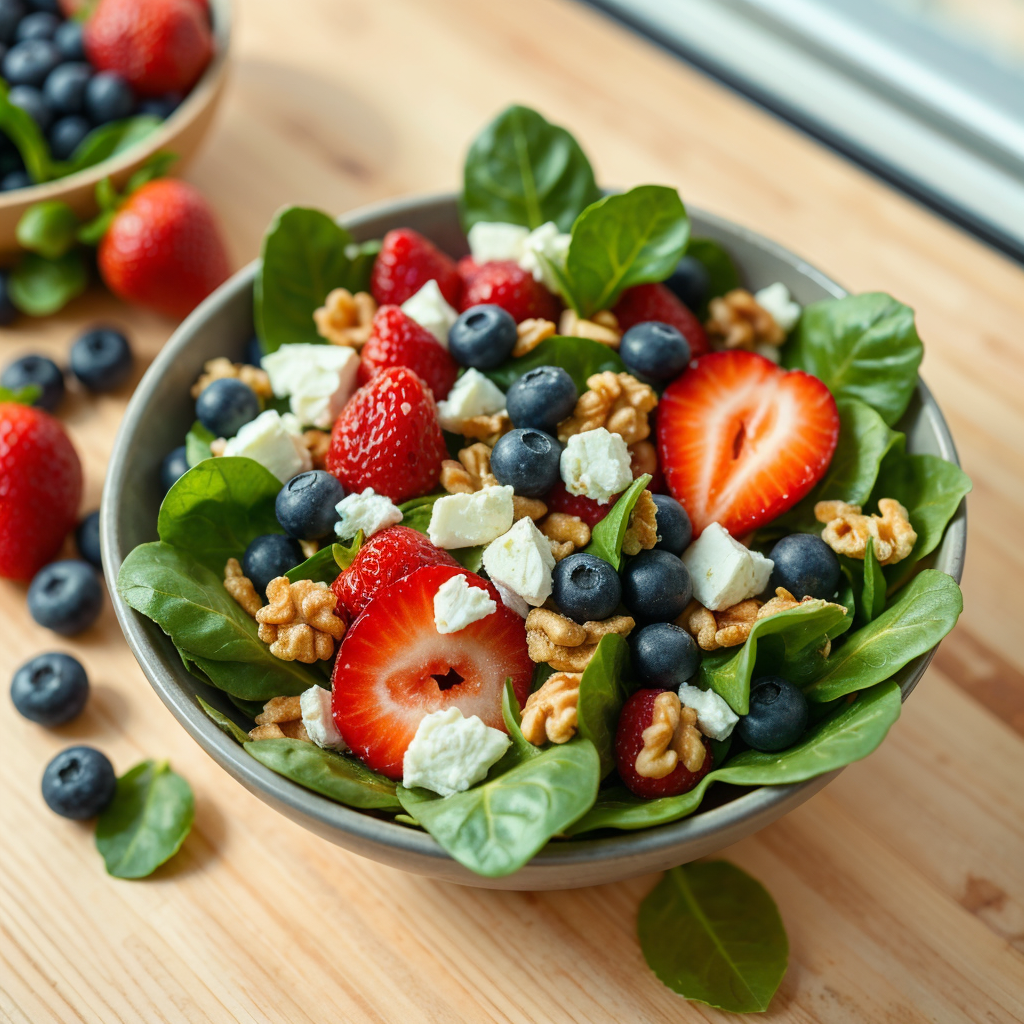
Ingredients:
– 4 cups fresh spinach
– 1 cup mixed berries (blueberries, strawberries, raspberries)
– 1/4 cup sliced almonds
– 1/4 cup feta cheese, crumbled
– 2 tablespoons chia seeds
Dressing:
– 2 tablespoons olive oil
– 1 tablespoon balsamic vinegar
– 1 teaspoon honey
– Salt and pepper to taste
Instructions:
- Prepare the Dressing: In a small bowl, whisk together olive oil, balsamic vinegar, honey, salt, and pepper until well combined.
- Assemble the Salad: In a large bowl, combine fresh spinach, mixed berries, sliced almonds, and feta cheese.
- Add the Dressing: Drizzle the dressing over the salad and toss gently to combine.
- Top with Chia Seeds: Sprinkle chia seeds on top for an extra nutritional boost.
Nutritional Value (per serving):
| Nutritional Information | Value |
|---|---|
| Calories | 250 kcal |
| Protein | 6g |
| Carbohydrates | 20g |
| Fat | 16g |
| Fiber | 5g |
| Key Nutrients | Vitamin C, Vitamin K, Antioxidants, Omega-3 fatty acids |
Insights:
This vibrant salad is packed with antioxidants from berries and spinach, healthy fats from almonds, and protein from feta cheese. Chia seeds add an extra boost of omega-3s and fiber, making it a perfect meal to fight inflammation and keep you energized throughout the day.
2. Mediterranean Quinoa Salad
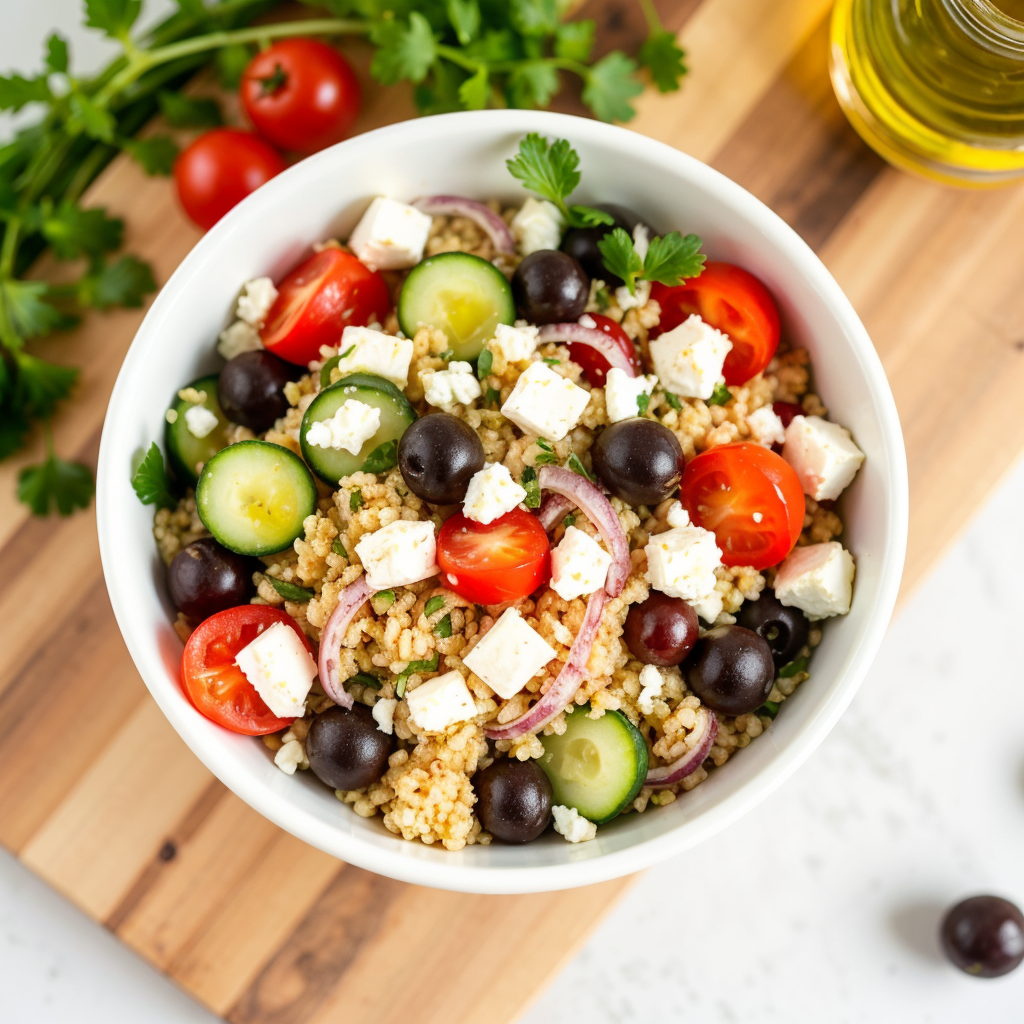
Ingredients:
– 1 cup cooked quinoa
– 1 cup cherry tomatoes, halved
– 1 cucumber, diced
– 1/2 cup Kalamata olives, pitted and sliced
– 1/4 cup red onion, finely chopped
– 1/4 cup fresh parsley, chopped
Dressing:
– 3 tablespoons olive oil
– Juice of 1 lemon
– 1 teaspoon dried oregano
– Salt and pepper to taste
Instructions:
- Prepare the Dressing: In a small bowl, whisk together olive oil, lemon juice, dried oregano, salt, and pepper.
- Combine Ingredients: In a large bowl, mix cooked quinoa, cherry tomatoes, cucumber, Kalamata olives, red onion, and fresh parsley.
- Dress the Salad: Pour the dressing over the salad and toss to ensure all ingredients are well coated.
- Chill and Serve: Refrigerate for at least 30 minutes to allow flavors to meld before serving.
Nutritional Value (per serving):
| Nutritional Information | Value |
|---|---|
| Calories | 300 kcal |
| Protein | 8g |
| Carbohydrates | 35g |
| Fat | 14g |
| Fiber | 6g |
| Key Nutrients | Magnesium, Vitamin C, Healthy Fats, Antioxidants |
Insights:
This Mediterranean-inspired quinoa salad is a hearty and nutritious option that combines the protein-rich quinoa with fresh vegetables and olives. The lemon and oregano dressing adds a zesty flavor while providing additional anti-inflammatory benefits. It’s perfect for meal prepping and enjoying throughout the week.
Related: Top 10 Easy To Make Anti-Inflammatory Breakfasts Ideas
3. Turmeric Roasted Vegetable Salad
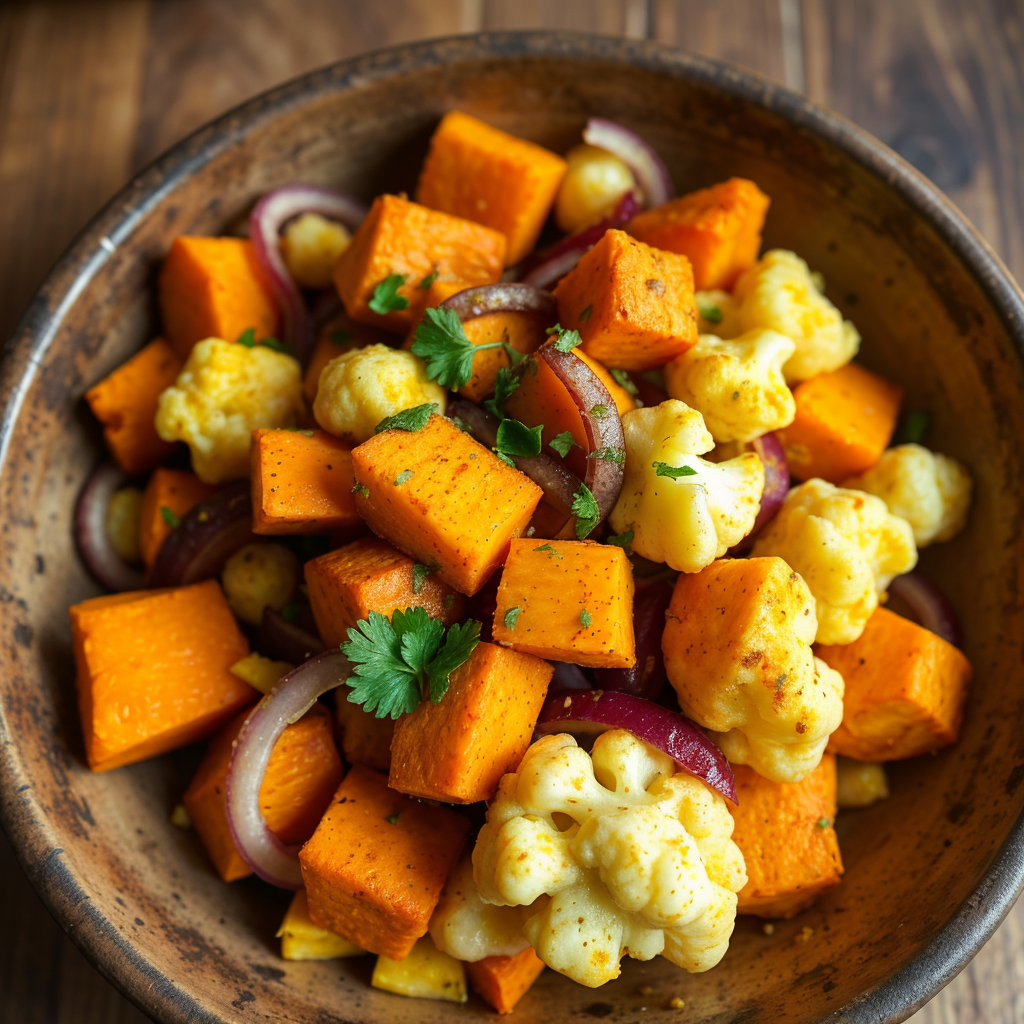
Ingredients:
– 2 cups mixed vegetables (sweet potatoes, carrots, Brussels sprouts), diced
– 1 teaspoon turmeric powder
– 2 tablespoons olive oil
– Salt and pepper to taste
– 4 cups mixed greens
– 1/4 cup pumpkin seeds
– 1 avocado, sliced
Dressing:
– 3 tablespoons tahini
– 1 tablespoon olive oil
– Juice of 1 lemon
– 1 teaspoon turmeric
– 1 garlic clove, minced
– Salt and pepper to taste
Instructions
- Roast the Vegetables Preheat the oven to 400°F (200°C). Toss the diced vegetables with olive oil, turmeric, salt, and pepper. Spread them on a baking sheet and roast for 25-30 minutes until tender and golden.
- Prepare the Dressing: In a bowl, whisk together tahini, olive oil, lemon juice, turmeric, minced garlic, salt, and pepper until smooth.
- Assemble the Salad: In a large bowl, combine mixed greens, roasted vegetables, pumpkin seeds, and avocado slices.
- Dress the Salad: Drizzle the tahini dressing over the salad and toss gently to combine.
Nutritional Value (per serving):
| Nutritional Information | Value |
|---|---|
| Calories | 350 kcal |
| Protein | 7g |
| Carbohydrates | 30g |
| Fat | 22g |
| Fiber | 8g |
| Key Nutrients | Vitamin A, Vitamin C, Healthy Fats, Anti-Inflammatory Compounds |
Insights:
Roasting vegetables with turmeric enhances their anti-inflammatory properties while adding a rich, earthy flavor. The creamy tahini dressing complements the roasted veggies perfectly, making this salad both satisfying and beneficial for reducing inflammation.
4. Avocado and Grapefruit Salad with Citrus Vinaigrette

Ingredients:
– 2 avocados, sliced
– 2 grapefruits, segmented
– 4 cups arugula
– 1/2 red onion, thinly sliced
– 1/4 cup toasted walnuts
Dressing:
– 3 tablespoons olive oil
– Juice of 1 orange
– 1 tablespoon honey
– 1 teaspoon Dijon mustard
– Salt and pepper to taste
Instructions:
- Prepare the Dressing: In a small bowl, whisk together olive oil, orange juice, honey, Dijon mustard, salt, and pepper until emulsified.
- Assemble the Salad In a large bowl, combine arugula, avocado slices, grapefruit segments, and red onion.
- Add the Dressing Drizzle the citrus vinaigrette over the salad and toss gently to mix.
- Top with Walnuts: Sprinkle toasted walnuts on top for added crunch and healthy fats.
Nutritional Value(per serving):
| Nutritional Information | Value |
|---|---|
| Calories | 320 kcal |
| Protein | 6g |
| Carbohydrates | 25g |
| Fat | 22g |
| Fiber | 7g |
| Key Nutrients | Vitamin C, Healthy Fats, Antioxidants, Omega-3 Fatty Acids |
Insights:
The combination of creamy avocado and tangy grapefruit creates a delightful balance of flavors. Arugula adds a peppery bite, while toasted walnuts provide a satisfying crunch and boost of omega-3s. This salad is refreshing and perfect for a light, anti-inflammatory meal.
5. Kale and Sweet Potato Salad with Tahini Dressing
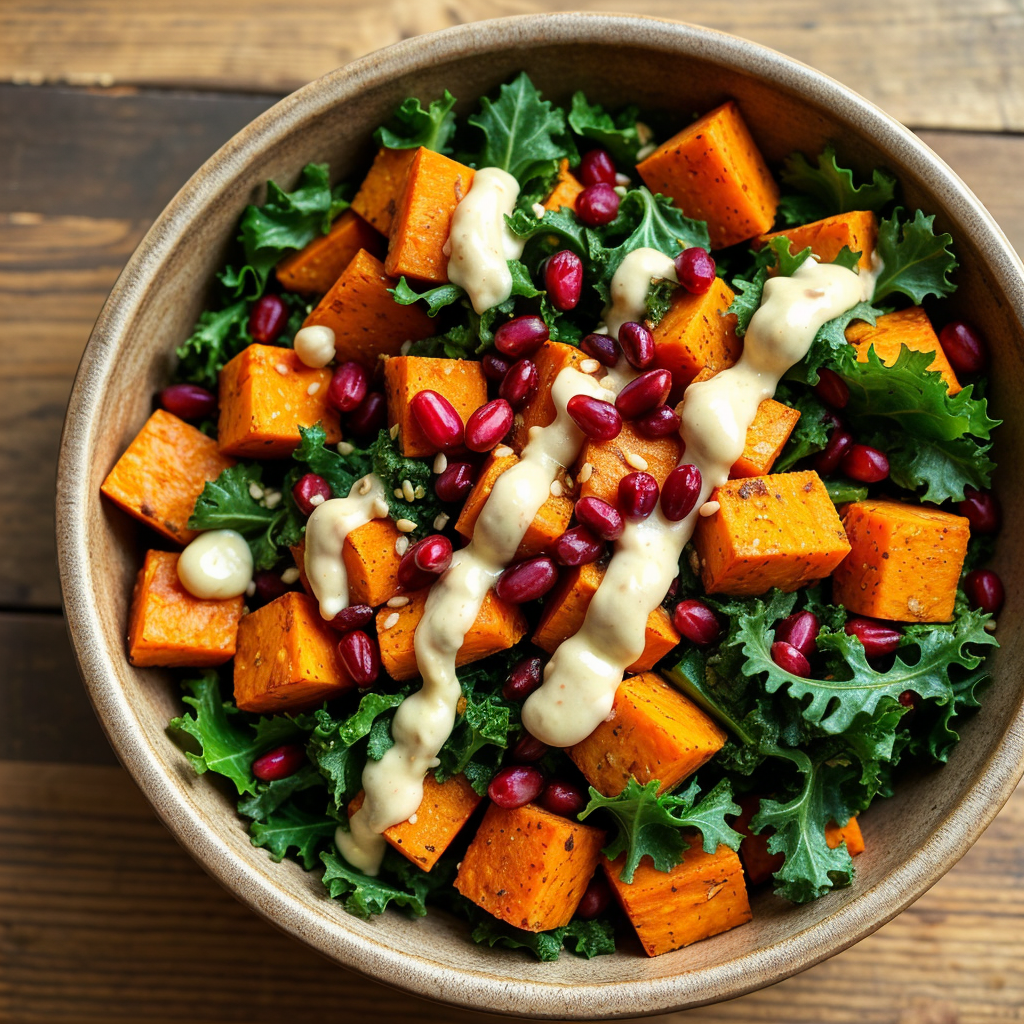
Ingredients:
– 4 cups massaged kale, chopped
– 2 cups roasted sweet potatoes, cubed
– 1/4 cup pomegranate seeds
– 1/4 cup pumpkin seeds
Dressing:
– 3 tablespoons tahini
– 2 tablespoons olive oil
– Juice of 1 lemon
– 1 tablespoon maple syrup
– Salt and pepper to taste
Instructions:
- Roast the Sweet Potatoes: Preheat the oven to 400°F (200°C). Toss sweet potato cubes with a little olive oil, salt, and pepper. Roast for 25-30 minutes until tender and caramelized.
- Prepare the Dressing: In a bowl, whisk together tahini, olive oil, lemon juice, maple syrup, salt, and pepper until smooth.
- Assemble the Salad: In a large bowl, combine massaged kale, roasted sweet potatoes, pomegranate seeds, and pumpkin seeds.
- Dress the Salad: Pour the tahini dressing over the salad and toss thoroughly to ensure everything is well coated.
Nutritional Value (per serving):
| Nutritional Information | Value |
|---|---|
| Calories | 400 kcal |
| Protein | 8g |
| Carbohydrates | 35g |
| Fat | 25g |
| Fiber | 10g |
| Key Nutrients | Vitamin K, Vitamin A, Iron, Antioxidants |
Insights:
Massaging kale helps soften its texture and make it more palatable. The sweet potatoes add natural sweetness and fiber, while pomegranate seeds contribute antioxidants. The creamy tahini dressing ties all the flavors together, making this salad both nutritious and delicious.
6. Salmon and Broccoli Slaw Salad
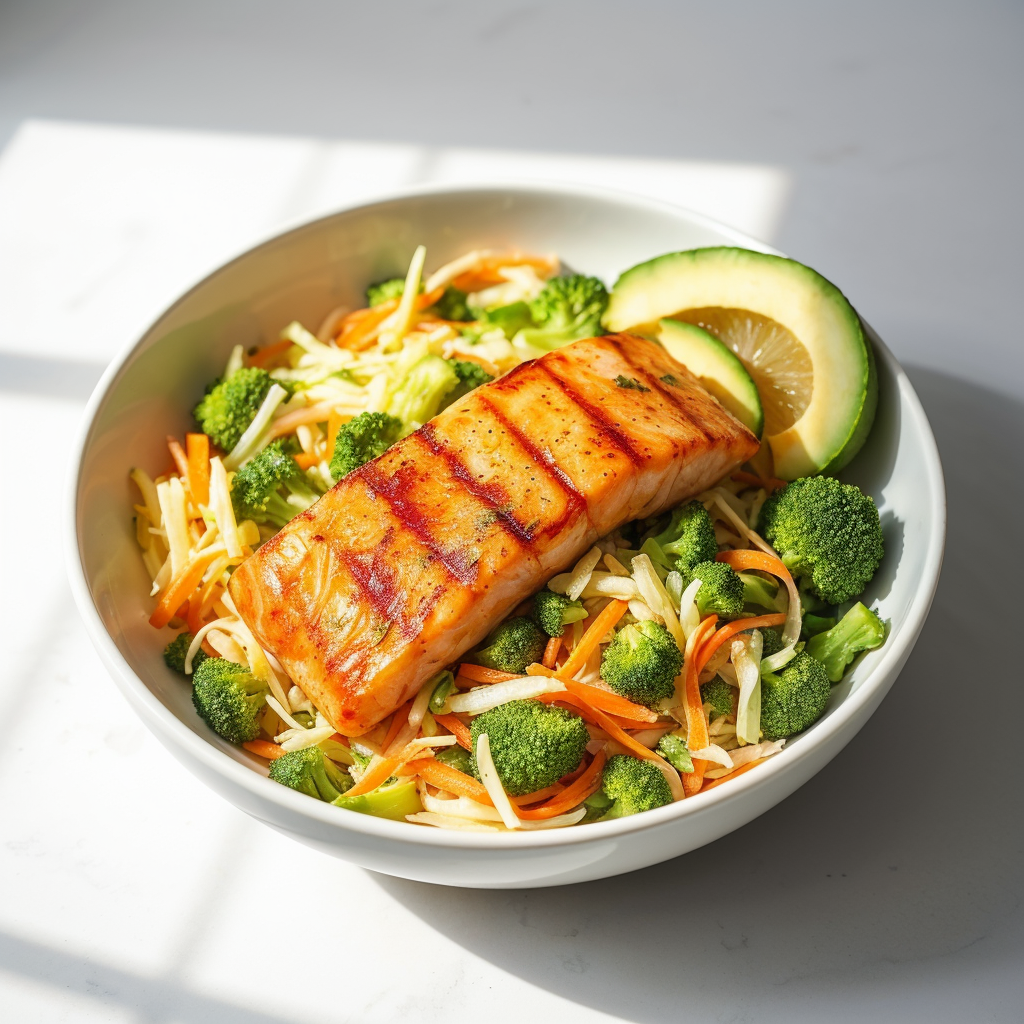
Ingredients:
– 2 grilled salmon fillets, flaked
– 3 cups broccoli slaw mix
– 1 cup shredded carrots
– 1/2 cup red cabbage, thinly sliced
– 2 tablespoons sesame seeds
Dressing:
– 3 tablespoons olive oil
– 2 tablespoons rice vinegar
– 1 tablespoon soy sauce or tamari
– 1 teaspoon grated ginger
– 1 teaspoon honey or maple syrup
– Salt and pepper to taste
Instructions:
- Prepare the Dressing: In a small bowl, whisk together olive oil, rice vinegar, soy sauce, grated ginger, honey, salt, and pepper.
- Assemble the Salad: In a large bowl, combine broccoli slaw mix, shredded carrots, and red cabbage.
- Add the Salmon: Gently fold in the flaked grilled salmon.
- Dress the Salad: Pour the dressing over the salad and toss to combine.
- Top with Sesame Seeds: Sprinkle sesame seeds on top for added crunch and flavor.
Nutritional Value (per serving):
| Nutritional Information | Value |
|---|---|
| Protein | 25g |
| Carbohydrates | 20g |
| Fat | 30g |
| Fiber | 8g |
| Key Nutrients | Omega-3 Fatty Acids, Vitamin C, Fiber, Protein |
Insights:
This hearty salad combines the rich flavors of grilled salmon with the crunchy texture of broccoli slaw. The ginger-infused dressing adds a zesty kick while providing anti-inflammatory benefits. It’s a balanced meal that offers plenty of protein and healthy fats to keep you satisfied.
Related: Top 9 Anti-Inflammatory Drinks for Better Health
7. Asian-Inspired Ginger Sesame Salad

Ingredients:
– 4 cups mixed greens
– 1 cup edamame, shelled and cooked
– 1 cup shredded carrots
– 1 cucumber, thinly sliced
– 3 green onions, chopped
Dressing:
– 3 tablespoons sesame oil
– 2 tablespoons rice vinegar
– 1 tablespoon soy sauce or tamari
– 1 tablespoon grated ginger
– 1 garlic clove, minced
– 1 teaspoon honey or maple syrup
Instructions:
- Prepare the Dressing: In a bowl, whisk together sesame oil, rice vinegar, soy sauce, grated ginger, minced garlic, and honey until well combined.
- Assemble the Salad: In a large bowl, combine mixed greens, edamame, shredded carrots, cucumber slices, and chopped green onions.
- Dress the Salad: Pour the ginger sesame dressing over the salad and toss to ensure even distribution.
- Serve: Garnish with additional sesame seeds if desired.
Nutritional Value (per serving):
| Nutritional Information | Value |
|---|---|
| Calories | 350 kcal |
| Protein | 15g |
| Carbohydrates | 25g |
| Fat | 20g |
| Fiber | 7g |
| Key Nutrients | Protein, Vitamin A, Vitamin C, Healthy Fats |
Insights:
This Asian-inspired salad is packed with protein from edamame and the vibrant flavors of ginger and sesame. The combination of crunchy vegetables and the nutty dressing makes it a satisfying and anti-inflammatory meal option that’s perfect for lunch or dinner.
8. Greek-Style Anti-Inflammatory Salad
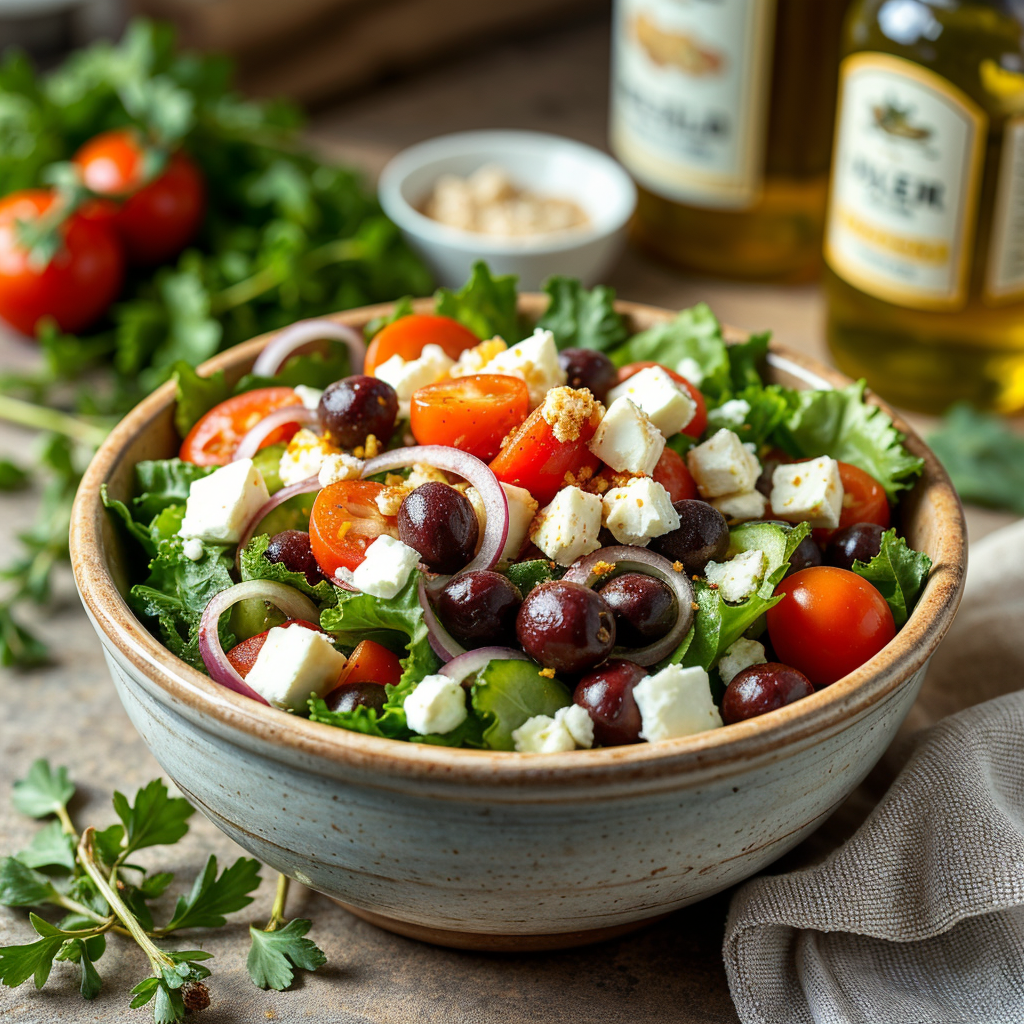
Ingredients:
– 4 cups romaine lettuce, chopped
– 1 cup cherry tomatoes, halved
– 1 cucumber, diced
– 1/2 red onion, thinly sliced
– 1/2 cup Kalamata olives, pitted and sliced
– 1/4 cup feta cheese, crumbled
Dressing:
– 3 tablespoons olive oil
– 2 tablespoons red wine vinegar
– 1 teaspoon dried oregano
– Salt and pepper to taste
Instructions:
- Prepare the Dressing: In a small bowl, whisk together olive oil, red wine vinegar, dried oregano, salt, and pepper.
- Assemble the Salad: In a large bowl, combine romaine lettuce, cherry tomatoes, cucumber, red onion, and Kalamata olives.
- Add Feta Cheese: Sprinkle crumbled feta cheese over the top.
- Dress the Salad: Drizzle the dressing over the salad and toss gently to combine.
Nutritional Value (per serving):
| Nutritional Information | Value |
|---|---|
| Calories | 300 kcal |
| Protein | 8g |
| Carbohydrates | 15g |
| Fat | 22g |
| Fiber | 5g |
| Key Nutrients | Calcium, Vitamin K, Healthy Fats, Antioxidants |
Insights:
A classic Greek salad updated with anti-inflammatory ingredients, this recipe features fresh vegetables and olives rich in healthy fats. The tangy feta adds creaminess and protein, making it a balanced and flavorful option for any meal.
9. Rainbow Chopped Salad with Lemon Garlic Dressing
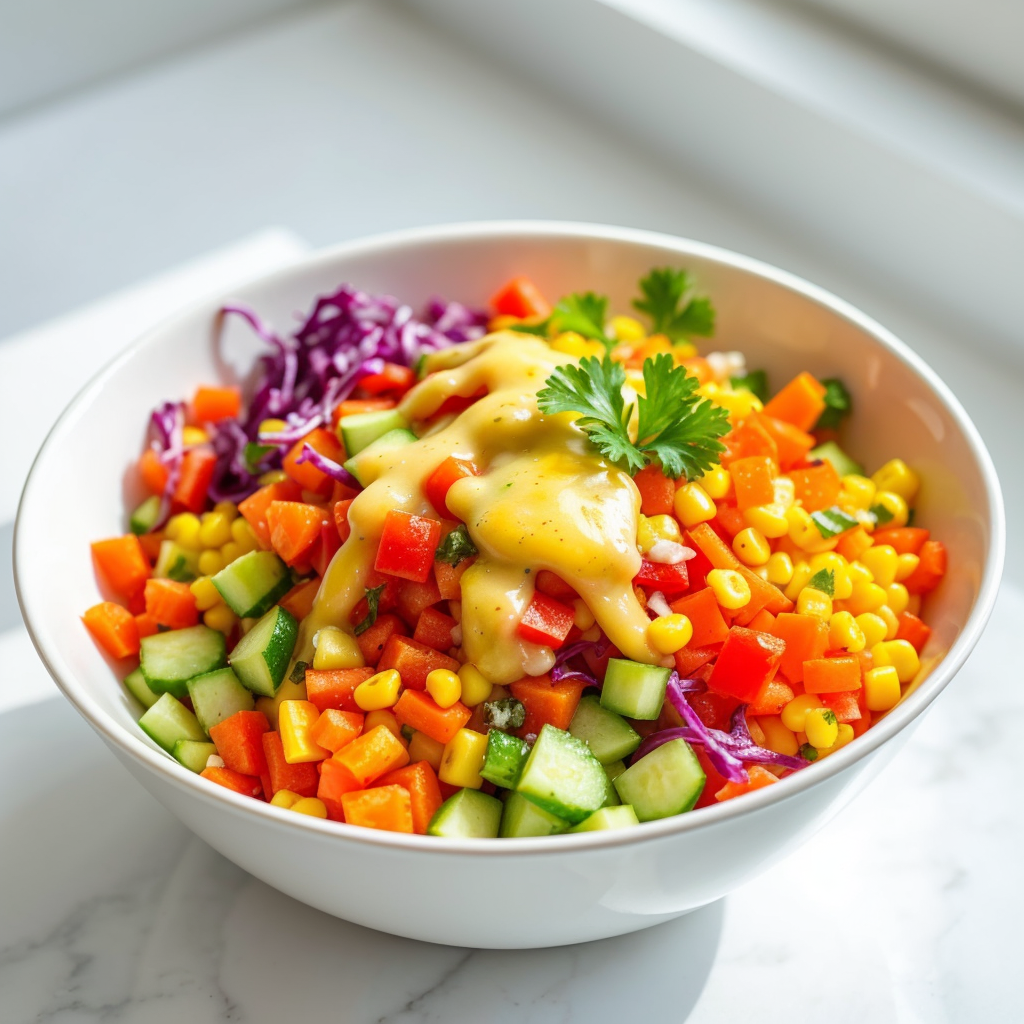
Ingredients:
– 1 red bell pepper, chopped
– 1 yellow bell pepper, chopped
– 1 green bell pepper, chopped
– 1/2 red cabbage, thinly sliced
– 2 carrots, shredded
– 1 avocado, diced
Dressing:
– 3 tablespoons olive oil
– Juice of 1 lemon
– 2 garlic cloves, minced
– 1 teaspoon Dijon mustard
– Salt and pepper to taste
Instructions:
- Prepare the Dressing: In a small bowl, whisk together olive oil, lemon juice, minced garlic, Dijon mustard, salt, and pepper.
- Assemble the Salad: In a large bowl, combine chopped bell peppers, red cabbage, shredded carrots, and diced avocado.
- Dress the Salad: Pour the lemon garlic dressing over the salad and toss gently to mix.
- Serve: Enjoy immediately or refrigerate for later.
Nutritional Value (per serving):
| Nutritional Information | Value |
|---|---|
| Calories | 280 kcal |
| Protein | 5g |
| Carbohydrates | 25g |
| Fat | 18g |
| Fiber | 8g |
| Key Nutrients | Vitamin C, Healthy Fats, Fiber, Antioxidants |
Insights:
This vibrant, colorful salad not only looks appealing but also offers a variety of textures and flavors. The lemon garlic dressing adds a zesty punch while avocado provides creaminess and healthy fats, making this salad both delicious and nutritious.
10. Walnut and Apple Salad with Maple Vinaigrette
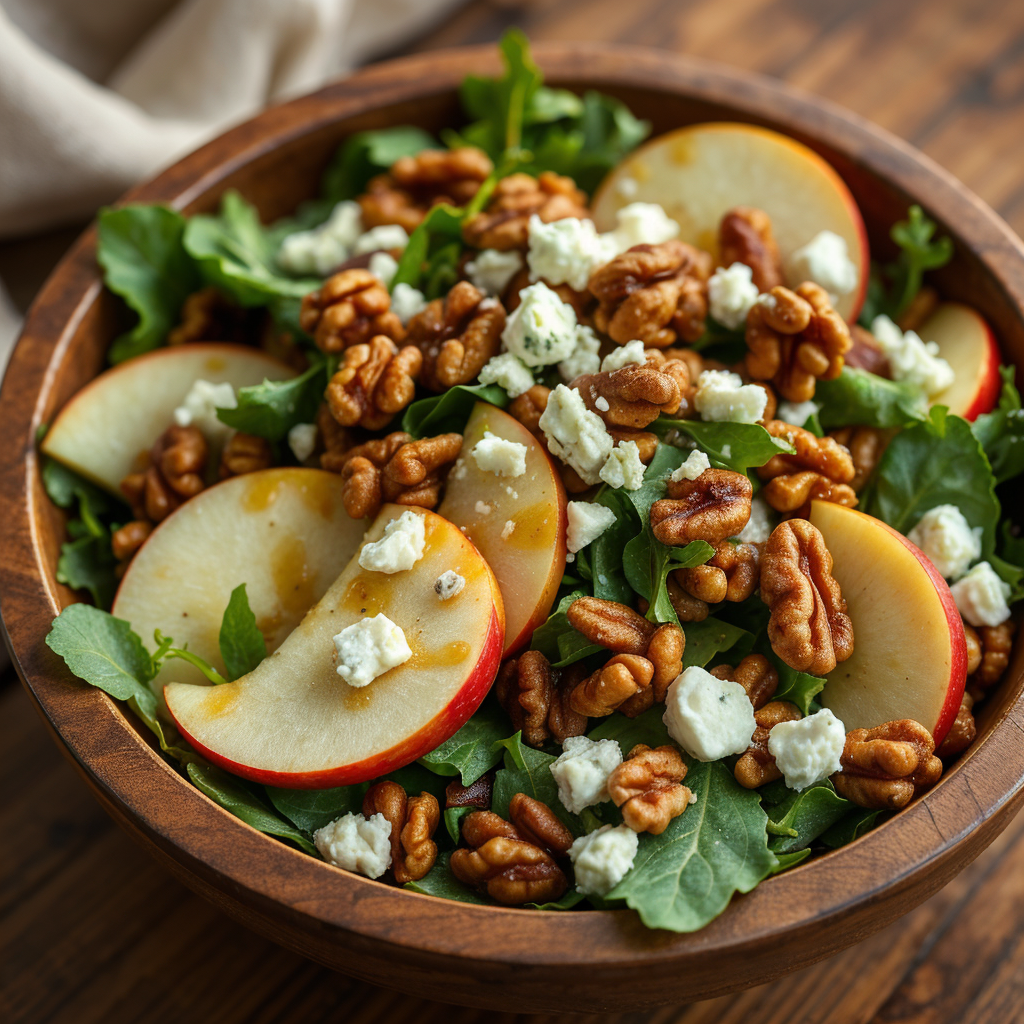
Ingredients:
– 4 cups mixed greens
– 2 apples, thinly sliced
– 1/2 cup walnuts, toasted
– 1/4 cup dried cranberries
– 1/4 cup goat cheese, crumbled
Dressing:
– 3 tablespoons olive oil
– 2 tablespoons apple cider vinegar
– 1 tablespoon maple syrup
– 1 teaspoon Dijon mustard
– Salt and pepper to taste
Instructions:
- Prepare the Dressing: In a small bowl, whisk together olive oil, apple cider vinegar, maple syrup, Dijon mustard, salt, and pepper until well combined.
- Assemble the Salad: In a large bowl, combine mixed greens, thinly sliced apples, toasted walnuts, and dried cranberries.
- Add Goat Cheese: Sprinkle crumbled goat cheese over the top.
- Dress the Salad: Drizzle the maple vinaigrette over the salad and toss gently to ensure all ingredients are evenly coated.
Nutritional Value (per serving):
| Nutritional Information | Value |
|---|---|
| Calories | 350 kcal |
| Protein | 7g |
| Carbohydrates | 30g |
| Fat | 22g |
| Fiber | 6g |
| Key Nutrients | Vitamin E, Healthy Fats, Antioxidants, Fiber |
Insights:
The combination of sweet apples, crunchy walnuts, and creamy goat cheese creates a delightful balance of flavors and textures. The maple vinaigrette adds a touch of sweetness while providing healthy fats from olive oil. This salad is perfect for fall but enjoyable year-round.
Conclusion
Anti-inflammatory salads are a simple yet powerful way to enhance your diet and improve your health. By understanding the key ingredients and incorporating a variety of flavors and textures, you can create delicious meals that support your body’s fight against chronic inflammation. Start experimenting with the recipes and tips provided in this guide, and take a step towards a healthier, more vibrant you.
Start incorporating anti-inflammatory salads into your daily meals today and experience the transformative benefits with every bite!
FAQ
Are raw vegetables always better for anti-inflammatory benefits?
While raw vegetables retain more nutrients, cooking certain vegetables (like tomatoes and spinach) can enhance the bioavailability of some antioxidants. A mix of raw and cooked vegetables in your salads can provide a balance of nutrients.
Can I use frozen fruits and vegetables in my anti-inflammatory salads?
Yes! Frozen fruits and vegetables can be just as nutritious as fresh ones. They are often frozen at peak ripeness, preserving their vitamins and minerals. Just ensure they are free from added sugars or sauces.
How do I make my salads more filling without compromising on anti-inflammatory properties?
To create more filling salads, incorporate healthy fats (like avocado or nuts), lean proteins (such as grilled chicken or chickpeas), and whole grains (like quinoa or farro). These additions will enhance satiety while maintaining anti-inflammatory benefits.
How often should I eat anti-inflammatory salads to see results?
Incorporating anti-inflammatory salads into your diet several times a week can be beneficial. Consistency is key; aim for at least 3-4 servings per week to help reduce inflammation over time.
Can I follow an anti-inflammatory diet if I have food allergies or sensitivities?
Yes! The anti-inflammatory diet is flexible and can be tailored to accommodate food allergies or sensitivities. Focus on safe ingredients that provide anti-inflammatory benefits while avoiding allergens.



